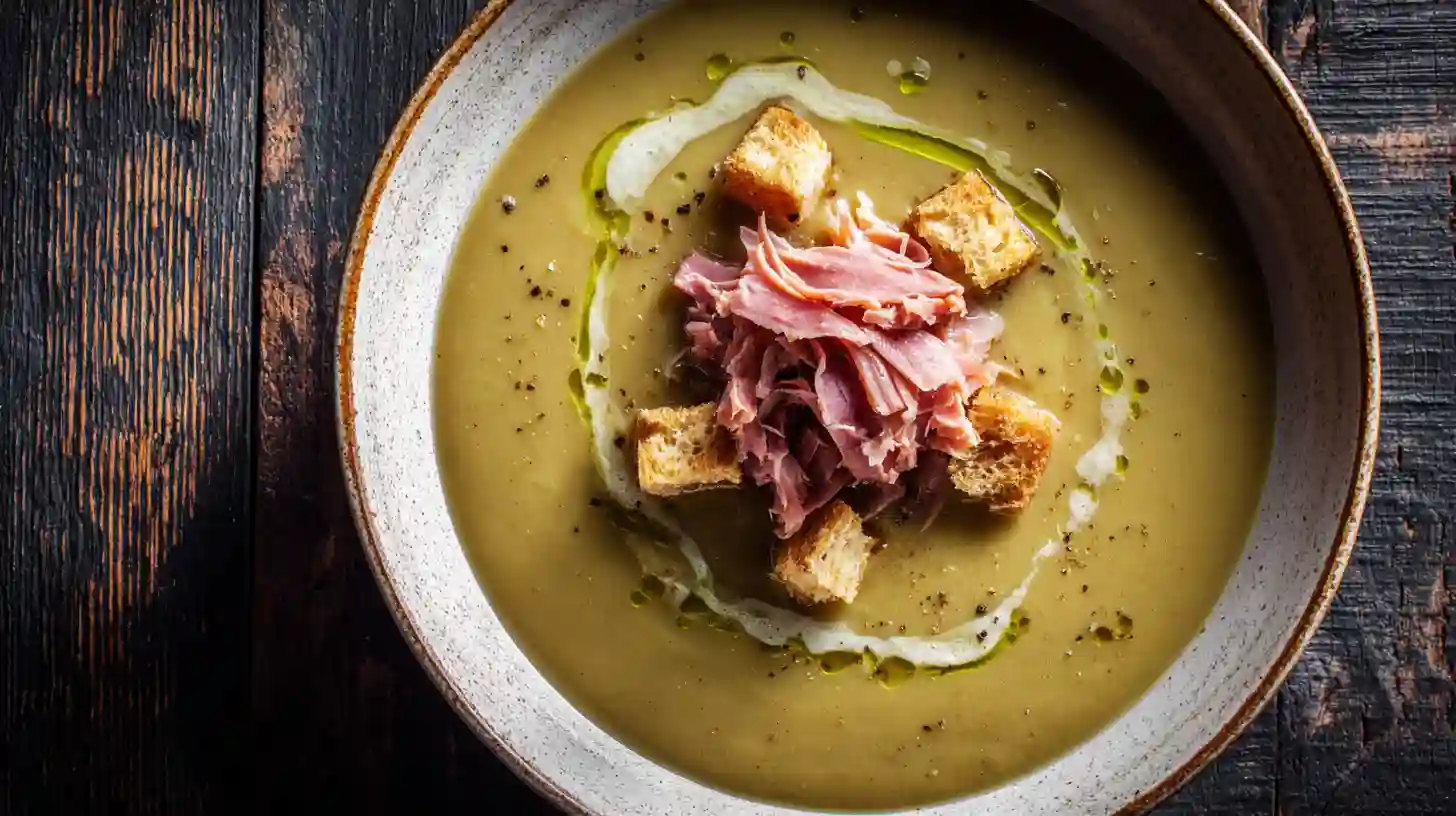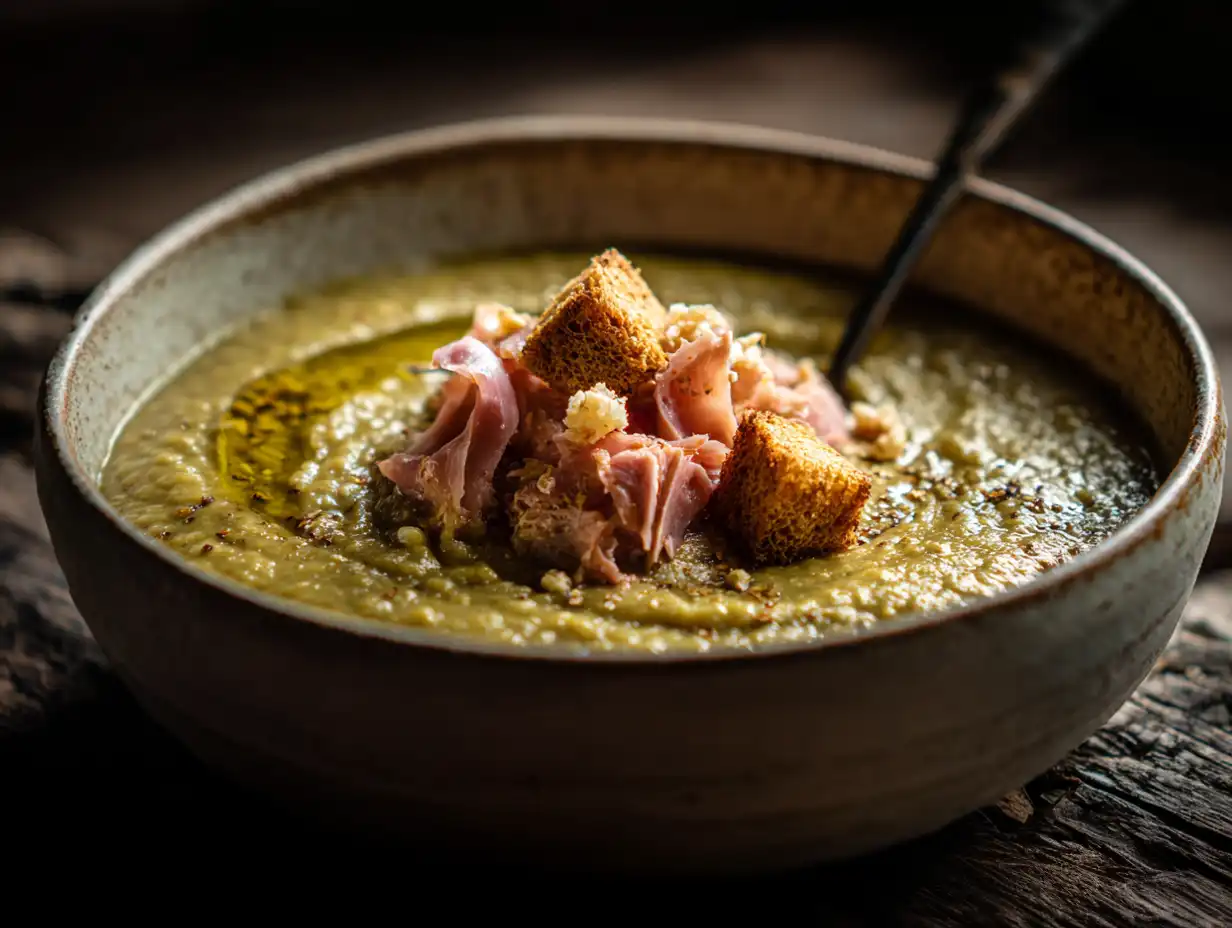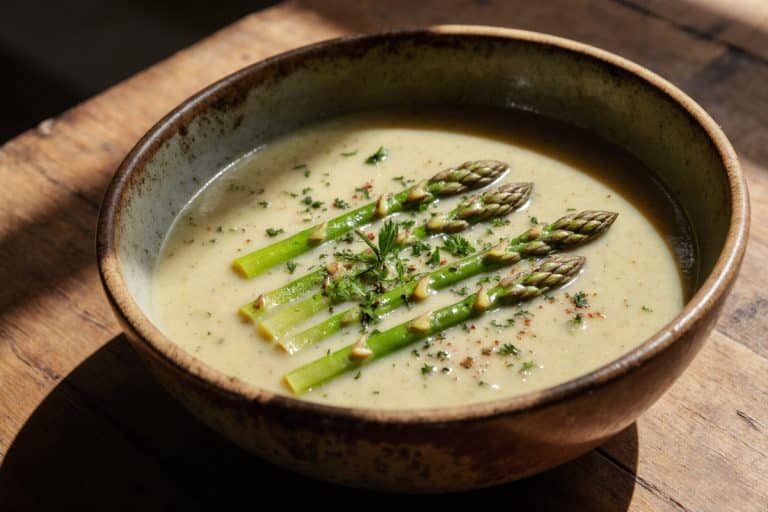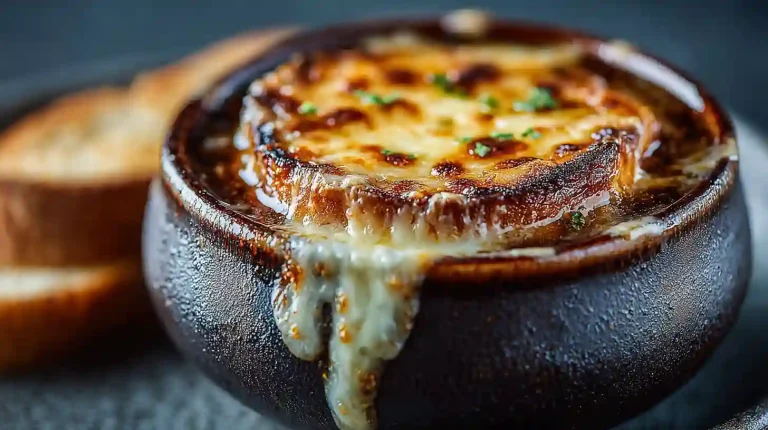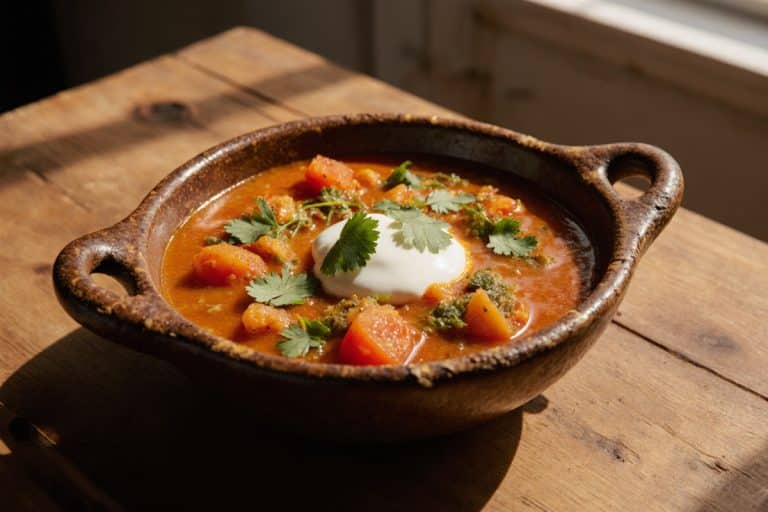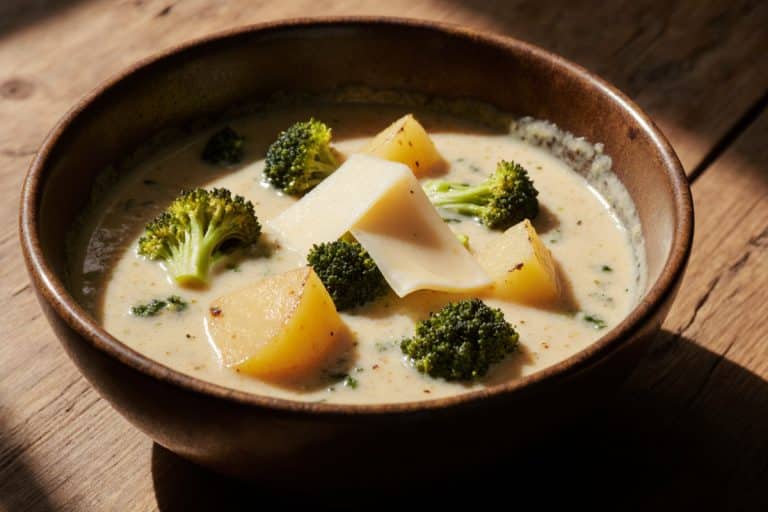Gordon Ramsay Split Pea Soup: The #1 Hearty & Authentic Recipe
Before we start, let’s be very clear. Gordon Ramsay has two famous pea soups. If you’re looking for the vibrant, bright green, elegant soup he makes on television with fresh peas, you are in the wrong place. This is the other one. This is the blueprint for his classic, hearty, slow-simmered Gordon Ramsay split pea soup—the ultimate winter comfort food. The method is completely different, and most online recipes get it disastrously wrong. I know, because my first attempt was a bland, gritty failure.
I’m Jack Barrett. I got tired of the confusion. I went back to the source material, analyzing the core principles of his rustic cooking. The secret to a phenomenal Gordon Ramsay split pea soup isn’t speed; it’s patience. It’s about building a deep, smoky flavor foundation and having the discipline to let the peas cook until they completely surrender their texture. This is the real method.
The Method: The Laws of a Classic Soup
A true Gordon Ramsay split pea soup is a masterclass in turning humble, inexpensive ingredients into something deeply satisfying. This isn’t a quick weeknight meal; it’s a low-and-slow project where flavor is built layer by layer. The integrity of a real Gordon Ramsay split pea soup depends on these laws.
- The Ham Hock Foundation: This is the most critical, non-negotiable law. The deep, smoky, savory flavor of a proper Gordon Ramsay split pea soup comes from a slow-simmered smoked ham hock. You are creating your own rich, porky stock from scratch. Using store-bought broth and diced ham is a catastrophic shortcut that will result in a bland, one-dimensional soup. The bone, the fat, and the smoked meat provide a complexity that cannot be faked.
- The Patient Simmer (The Secret to Smoothness): The #1 technical failure in a Gordon Ramsay split pea soup is a gritty texture. This is caused by impatience. The dried split peas need a long, low, patient simmer—for at least 1.5 to 2 hours—to allow their starches to break down completely. You’ll know they’re ready when they have “slumped” and started to fall apart on their own, creating a thick, porridge-like consistency before you even think about blending.
- The Soaking Debate (The Ramsay Approach): Many traditional recipes call for soaking the split peas overnight. While this can shorten the cooking time slightly, the Ramsay method favors efficiency and flavor. The more effective approach is to skip the overnight soak and simply extend the simmer. Cooking the peas from dry in the flavorful ham stock ensures they absorb that smoky goodness from the very beginning. This dedication to flavor is key to a perfect Gordon Ramsay split pea soup.
Mistake Watchouts: My Soup Was Gritty, So Yours Won’t Be
My first attempt to make a Gordon Ramsay split pea soup was a lesson in humility. I rushed the simmer, and the result was a thin broth with gritty, undercooked peas at the bottom. The flavor was weak, the texture was terrible. A proper Gordon Ramsay split pea soup should be thick, hearty, and velvety smooth. Here’s where I went wrong.
- The Mistake: A Bland, Watery Soup. My biggest failure. I used a store-bought stock and some diced ham, thinking it was a clever shortcut. The result was a soup that tasted of nothing. It lacked the deep, smoky, almost bacon-like flavor that is the signature of this dish.
- The Fix: Use a real smoked ham hock. There is no other way. The time invested in simmering the hock to create your own stock is the difference between a world-class Gordon Ramsay split pea soup and a forgettable bowl of mush.
- The Mistake: Gritty, Undercooked Peas. I got impatient after an hour and decided to blend the soup. The blender just whirred the hard bits of pea around, resulting in a sandy, unpleasant texture. A smooth Gordon Ramsay split pea soup cannot be rushed.
- The Fix: Patience. The simmer is not passive time; it is active cooking time. The peas must be completely soft and falling apart before you blend. Test them by squishing one against the side of the pot with a spoon. If it crushes easily into a paste, it’s ready.
The Recipe: Gordon Ramsay’s Classic Split Pea and Ham Soup
Gordon Ramsay’s Classic Split Pea and Ham Soup
Ingredients
Equipment
Method
- Rinse Peas: Place the dried split peas in a fine-mesh sieve and rinse them thoroughly under cold running water until the water runs clear.
- Build the Base: In a large stockpot or Dutch oven, combine the rinsed split peas, the smoked ham hock, chopped onion, carrots, celery, smashed garlic, and the bay leaf.
- The Long Simmer: Cover the ingredients with cold water or chicken stock by about 2 inches. Bring to a boil, then immediately reduce the heat to a very low simmer. Cook, partially covered, for 1.5 to 2.5 hours, stirring every 30 minutes to prevent sticking. The soup is ready for the next step when the peas are completely soft and falling apart and the meat is tender enough to easily pull from the bone.
- Prep the Ham: Carefully remove the ham hock from the pot. When cool enough to handle, use two forks or your fingers to shred all the meat from the bone. Discard the bone, skin, and any excess fat. Set the shredded ham aside. Remove and discard the bay leaf from the soup.
- Blend the Soup: Use an immersion blender to puree the soup directly in the pot until it reaches your desired consistency—from slightly chunky to perfectly smooth. Alternatively, carefully blend the soup in batches in a countertop blender.
- Finish and Serve: Return the shredded ham to the blended soup. Bring the soup back to a gentle simmer and cook for another 10 minutes to allow the flavors to meld. Taste and season generously with salt and black pepper. Ladle into warm bowls and garnish with croutons and a drizzle of olive oil.
Nutrition
Notes
Love this recipe?
Give us 5 stars and comment!The Execution: Step-by-Step
- Rinse Peas: Place the dried split peas in a sieve and rinse them thoroughly under cold running water.
- Make the Ham Stock: Place the rinsed peas, smoked ham hock, chopped onion, carrot, celery, and bay leaf in a large stockpot. Cover with cold water. Bring to a boil, then immediately reduce to a very low simmer.
- The Long Simmer: Simmer the soup, partially covered, for 1.5 to 2 hours. Stir occasionally to prevent the peas from sticking. The soup is ready for the next step when the peas are completely tender and starting to fall apart, and the ham meat is tender enough to shred.
- Prep the Meat: Carefully remove the ham hock from the pot. When it’s cool enough to handle, shred all the meat from the bone, discarding any skin and fat. Set the shredded meat aside. Remove the bay leaf from the soup and discard it.
- Blend the Soup: Use an immersion blender to puree the soup directly in the pot until it is as smooth as possible. Alternatively, carefully transfer the soup in batches to a high-powered blender and blend until velvety.
- Finish and Season: Return the shredded ham to the pot of soup. Bring back to a gentle simmer. Taste and season generously with salt and freshly ground black pepper.
- Serve: Ladle the hot soup into warm bowls. Garnish with a swirl of olive oil and some crunchy croutons.
Sanctioned Riffs (Variations That Respect the Method)
The core method of a Gordon Ramsay split pea soup—the ham hock and the long simmer—is fundamental. However, for a touch more flavor, you can sauté the aromatic vegetables (onion, carrot, celery) in a little butter before adding the peas and water. You can also add a sprig of thyme along with the bay leaf for an extra herbal note. The integrity of this Gordon Ramsay split pea soup comes from its simple, rustic, and deeply flavorful nature.
Plating and Execution
A Gordon Ramsay split pea soup is the definition of rustic comfort. It should be served thick and hot in a heavy, comforting bowl. The perfect garnish adds texture. A generous pile of the reserved shredded ham in the center, a handful of crunchy, golden-brown croutons, and a final drizzle of high-quality extra virgin olive oil are all you need. This is a hearty soup that eats like a meal.

Recipe FAQs
What is the difference between this Gordon Ramsay split pea soup and his fresh pea soup?
They are completely different dishes. This Gordon Ramsay split pea soup is a hearty, thick, rustic soup made from dried peas and slow-simmered for hours. The fresh pea soup is a light, elegant, vibrant green soup made from fresh or frozen peas that cooks in minutes.
Do I absolutely have to use a ham hock?
Yes. To achieve the authentic, deep, smoky flavor of a Gordon Ramsay split pea soup, the ham hock is non-negotiable. It creates its own rich stock, which is the soul of the dish.
How do I get my split pea soup perfectly smooth?
The secret is twofold: a very long, slow simmer that allows the peas to break down completely, followed by a blitz in a high-powered blender. If you rush the simmer, no amount of blending will remove the gritty texture of undercooked peas.
The Result & Conclusion
When you take the first spoonful, you understand the power of patience. The soup is incredibly thick, smooth, and velvety. The flavor is a deep, satisfying wave of smoky ham, sweet peas, and savory aromatics. It’s the kind of comforting, deeply nourishing dish that feels like it was cooked with soul. You didn’t just make soup. You took the humblest of ingredients and, through a proper, un-rushed method, created the perfect Gordon Ramsay split pea soup.
Your Turn. Get to Work.
You’ve mastered a classic comfort food by respecting the power of slow cooking. Now apply that same philosophy to other foundational dishes. Continue your education with the definitive guide to Gordon Ramsay’s Soups and Chowders Recipes.

